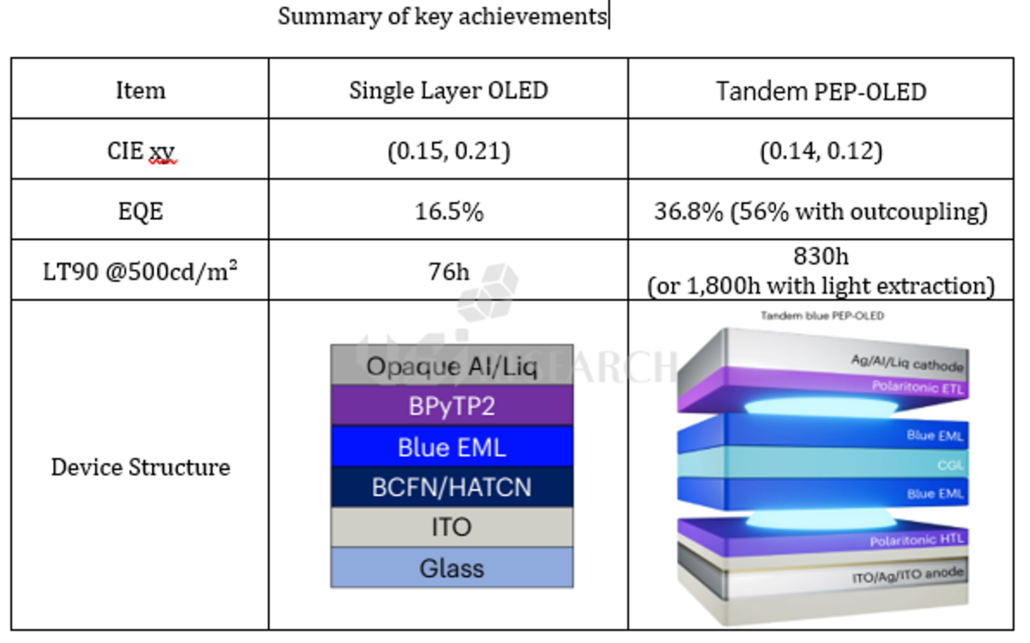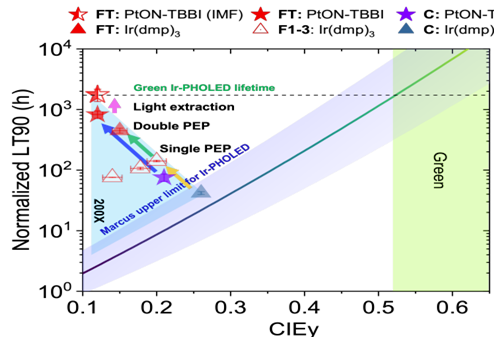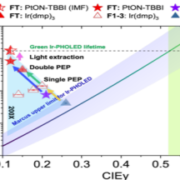University of Michigan team boosts blue phosphorescent OLED lifetime. A breakthrough toward solving the “blue problem” in displays
May 2025 — A research team led by Professor Stephen R. Forrest at the University of Michigan has developed a deep blue phosphorescent OLED (PhOLED) that simultaneously achieves up to more than 10 times longer lifetime and high color purity, addressing the long-standing challenge of blue OLEDs. The results are published in the latest issue of Nature Photonics, and a related paper was presented at SID2025.
While OLEDs are widely used in smartphones and premium TVs, blue OLEDs have relied on inefficient fluorescence, leading to high power consumption and short operational lifetimes. This is because blue light has the highest energy level, causing molecules in the emitting layer to degrade quickly. To overcome this, the team developed a tandem PEP (polariton-enhanced Purcell effect) OLED with multilayer architecture and double-sided electrode design.
Previous work by the Forrest team demonstrated that surface plasmons near metal electrodes could help excitons in light-emitting molecules release energy faster. Building on this, the new device incorporates an organic semiconductor on both electrodes, enabling the formation of plasmon–exciton–polaritons. This structure acts like a high-speed lane, allowing excitons to convert to photons more efficiently and reducing destructive interactions.
Moreover, the tandem architecture divides the light-emission workload between two layers, cutting degradation in half. An optical cavity (Fabry–Pérot cavity) further boosts efficiency and color purity.
First author Dr. Haonan Zhao stated, “Instead of letting excitons collide and decay, we gave them an expressway to escape — a physical design solution to a two-decade-old problem.” Professor Forrest added, “This may not be the final solution, but we’ve finally shown the way forward that has eluded researchers for 20 years.”
The results of this study are expected to play a key role in advancing the performance of various display products, such as next-generation smartphones, TVs, and wearable devices. It also has the potential to bring about innovative changes in the lighting field, where energy efficiency is important. This study was supported by the US Department of Energy and Universal Display Corporation.


Paper Information
– Title: Stable, deep blue tandem phosphorescent organic light-emitting diode enabled by the double-sided polariton-enhanced Purcell effect
– Authors: Haonan Zhao, Claire E. Arneson, Stephen R. Forrest
– Journal: Nature Photonics (2025)
– Journal: SID 2025 Digest148 (13-4)
Chang Ho NOH, Analyst at UBI Research (chnoh@ubiresearch.com)


 2025 OLED Emitting Materials Report Sample
2025 OLED Emitting Materials Report Sample
